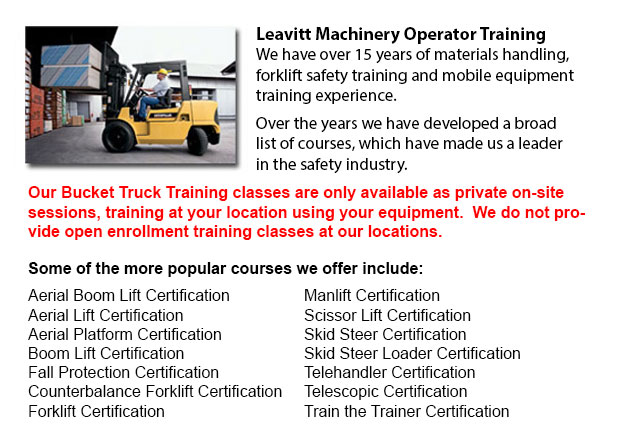
Barrie Bucket Truck Training - The Vehicle-Mounted Aerial Work Platform or likewise called bucket truck training program is designed to lessen the chance of incident and personal injury while working in close proximity or with bucket trucks by effectively training qualified operators. An aerial lift device is whatever vehicle-mounted device, telescoping or articulating, or both, which is made use of to position workers to reach spots that would otherwise be unreachable. Aerial lift devices are utilized to be able to elevate personnel to above-ground work sites.
The program aims to provide operators with the knowledge, skills, training materials and abilities needed to be able to efficiently and safely operate vehicle-mounted aerial work platforms.
The program has two portions: a hands-on session and a classroom training session. To become certified, participants must be successful in both parts. A wallet-size certificate and a full-size certificate will be issued upon finishing the program.
Types of lifts comprise extensible boom platforms, articulating boom platforms, aerial ladders and aerial ladder trucks, vertical towers and any combination of these devices. Aerial lift devices are usually made of metal, wood, reinforced plastic, fiberglass or other materials.
Definitions
Articulating boom platform: multiple hinged boom components.
Extensible boom platform: has a telescopic or extensible boom.
Platform: the part of an aerial device that is designed to carry staff.
Mobile unit: a combination of aerial devices, such as its vehicle and related machinery.
Employees who work with aerial devices have the responsibility of ensuring that they are correctly authorized and trained. Employees must ensure that people who are not trained and authorized do not utilize lift devices. Workers should make sure that they wear the correct protective equipment if working from the platform.
The course content utilized in the bucket truck training program consists of operating the vehicle-mounted aerial work platform, pre-shift inspections, safe operating practices, lifting capacity, use of emergency controls, and administering theory and practical tests. Operators will become familiar with rules under the local and federal regulations.
-
Barrie Warehouse Forklift Safety Training
Barrie Warehouse Forklift Safety Training - Businesses normally face liability for injuries and damage sustained in workplace accidents. Warehouses can be hazardous places to the individuals who work there. That is the reason why employee safety is a... More -
Barrie Aerial Platform Training
Barrie Aerial Platform Training - Aerial lifts can accommodate many duties involving high and tricky reaching places. Normally used to carry out regular upkeep in buildings with high ceilings, prune tree branches, hoist heavy shelving units or mend p... More -
Barrie Forklift Ticket
Barrie Forklift Ticket - Pallet jacks and lift trucks are both intended for practically the same reason; to transfer goods from one location of your warehouse to another. This is basically where the comparison stops however. With the pallet jack, the... More -
Barrie Aerial Lift Training
Barrie Aerial Lift Training - An aerial work platform is a mechanized access platform. This machinery provides access to otherwise not accessible places for people or equipment. Also referred to as an aerial device or elevating work platform, the mac... More -
Barrie Aerial Boom Lift Training
Barrie Aerial Boom Lift Training - For people who operate or supervise the use of aerial lift platforms, correct aerial boom lift Training is required. The aerial lift platform is utilized for lifting individuals, tools and materials to elevated work... More -
Barrie Manlift Certification
Barrie Manlift Certification - The Elevated Platforms and Manlifts Certification program helps to provide the needed training on the work practices, safe operating procedures, rules and regulations regarding the everyday activities for the operators... More -
Barrie Overhead Crane Certification
Barrie Overhead Crane Certification - The overhead crane training certification course is designed to be effective with all participants regardless of literacy or language limitations. The course has two parts: a classroom training session and a prac... More -
Wheel and Track Loader Training in Barrie
Lift trucks are obtainable in several various units that have varying load capacities. The majority of typical lift trucks utilized in warehouse settings have load capacities of one to five tons. Bigger scale models are used for heavier loads, such a... More

Forklift Certification Barrie
TOLL FREE: 1-888-254-6157
Barrie, Ontario
forkliftcertificationbarrie.com
Email Us
About Us


